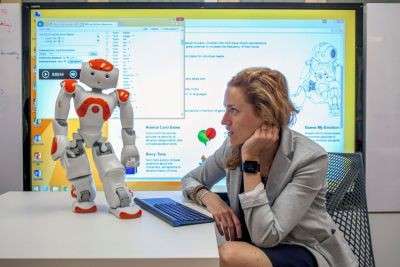Could robots help unlock the mystery of autism spectrum disorder?

Given the many mysteries around autism spectrum disorder (ASD), researchers are always looking for new and innovative ways to solve the mystery and one of the most interesting is using robots to venture into the question of language practice of children with ASD.
And robots, it turns out, may hold a key to promoting better human interactions for some children with autism.
The road to this research began for Stéphanie Walsh Matthews, a professor in the Department of Languages, Literatures and Cultures, when she was invited to collaborate with an international consortium researching robots and working with the elderly. Her research in the semiotic functions of repulsion and attraction appealed to the researchers working with geriatric users. Researchers developing cute and playful robots also noticed that children with ASD actively engaged with them. For one child, interacting with a robot prompted him to speak … something he had not done before.
"It opened up this large world where people started questioning why some children have an inclination to interact with robots," says Walsh Matthews, who now investigates the language practices with children with ASD using small robots with her Ryerson co-investigator Jamin Pelkey, also in Languages, Literatures and Cultures.
The study also gave Walsh Matthews the opportunity to use the robots to record the interactions between the children and the robots. "We had children playfully interact with the robots and collected a whole bunch of speech data and we are really proud to say we are building an original linguistic database of transcribed speech data from children with autism."
The key question is why this kinship with robots? Walsh Matthews says it may come down to this distinction – some children with autism spectrum disorder demonstrate a certain ease when interacting with the small robots. "What some researchers have come to understand is that children respond to robots because the robots tend to have a low stimulus level. Their faces don't move, they are very predictable. They tend to speak in steady, predictable sentences that are idiomatic. They tend to do things in repetition and they are tireless. They don't get impatient. They can play the same game many times over exactly the same way."
The end goal is not to consign children with autism to non-human interactions, though. The good news is the experience of interacting with robots suggests the children come away better able to communicate with other humans.
"We have noticed, along with other researchers, that children who do interact with robots actually take the skills they acquire during these robotic interactions and apply them to people and become more familiar. They just have a practicing buddy."





















